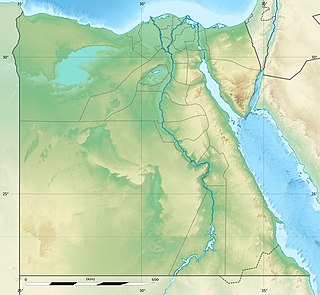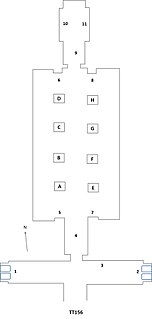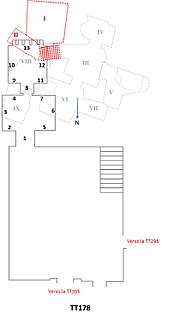 W
WThe Nineteenth Dynasty of Egypt is classified as the second Dynasty of the Ancient Egyptian New Kingdom period, lasting from 1292 BC to 1189 BC. The 19th Dynasty and the 20th Dynasty furthermore together constitute an era known as the Ramesside period. This Dynasty was founded by Vizier Ramesses I, whom Pharaoh Horemheb chose as his successor to the throne.
 W
WThe Abu Simbel temples are two massive rock temples at Abu Simbel, a village in Aswan Governorate, Upper Egypt, near the border with Sudan. They are situated on the western bank of Lake Nasser, about 230 km (140 mi) southwest of Aswan. The complex is part of the UNESCO World Heritage Site known as the "Nubian Monuments", which run from Abu Simbel downriver to Philae. The twin temples were originally carved out of the mountainside in the 13th century BC, during the 19th dynasty reign of the Pharaoh Ramesses II. They serve as a lasting monument to the king and his queen Nefertari, and commemorate his victory at the Battle of Kadesh. Their huge external rock relief figures have become iconic.
 W
WAmun-her-khepeshef was the firstborn son of Pharaoh Ramesses II and Queen Nefertari.
 W
WBay, also called Ramesse Khamenteru, was an important Asiatic official in ancient Egypt, who rose to prominence and high office under Seti II Userkheperure Setepenre and later became an influential powerbroker in the closing stages of the 19th Dynasty. He was generally identified with Irsu mentioned in the Great Harris Papyrus, although no contemporary source connects Bay with Irsu.
 W
WHori was a Vizier of Ancient Egypt. He served during the reign of pharaohs Sethi II, Siptah, Tawosret, Setnakhte and Ramesses III.
 W
WIrsu is the name used in Papyrus Harris I to designate a Khasu who became overlord of a group of local rulers nominally under Egyptian control, at a time of unrest between the Nineteenth and Twentieth Dynasties. The reading of the name is contested and the man may instead have simply been called Su. The events in which Irsu participated likely took place outside of the Nile Valley, in the Asiatic territories of Egypt's empire.
 W
W"Khonsuemheb and the ghost", often known simply as A ghost story, is an ancient Egyptian ghost story dating back to the Ramesside period. Its protagonist is a priest named Khonsuemheb and the story revolves around his encounter with a restless ghost.
 W
WNebneteru Tenry was an ancient Egyptian High Priest of Amun under Seti I.
 W
WThe ancient Egyptian artisan Pashedu lived in Deir el-Medina on the west bank of the Nile, opposite Thebes, during the reigns of Seti I. Pashedu was a son of Menna and Huy. His wife was named Nedjmet-behdet. Pashedu was the owner of tomb TT3 and likely TT326.
 W
WRamose was an ancient Egyptian scribe and artisan who lived in Deir el-Medina on the west bank of the Nile, opposite Thebes, during the reigns of Ramesses II. He held the position of Scribe of the Tomb, the highest administrative position for a scribe in Deir el-Medina, from around years 5 to 38 of Ramesses II's reign. He was buried in a tomb in the village necropolis.
 W
WThe sarcophagus of Seti I is a life-size sarcophagus of the 19th Dynasty Pharaoh that was rediscovered in 1817 by the Italian explorer Giovanni Battista Belzoni in the Valley of the Kings, Egypt. Seti I is believed to have died in 1279 BC and the sarcophagus would have housed his coffin and mummy. It was bought by architect Sir John Soane in 1824 for £2000 after the British Museum turned it down citing Belzoni's steep price. It is currently displayed in the crypt section, called Sepulchral Chamber, of Sir John Soane's Museum in London. Over 3000 years old, the sarcophagus is one of the oldest museum objects in the United Kingdom in public collection.
 W
WThe ancient Egyptian artisan Sennedjem lived in Set Maat, contemporary Deir el-Medina, on the west bank of the Nile, opposite Thebes, during the reigns of Seti I and Ramesses II. Sennedjem had the title "Servant in the Place of Truth". He was buried along with his wife, Iyneferti, and family in a tomb in the village necropolis. His tomb was discovered January 31, 1886. When Sennedjem's tomb was found, in it there was regular furniture from his home, including a stool and a bed, which he actually used when he was alive.
 W
WThe Theban Tomb TT41 is located in Sheikh Abd el-Qurna, part of the Theban Necropolis, on the west bank of the Nile, opposite to Luxor. It is the burial place of the ancient Egyptian Amenemopet called Ipy, whose title was Chief Steward of Amun in the Southern City. He dates to the time of Ramesses I, Sethi I and Ramesses II from the Nineteenth Dynasty of Egypt
 W
WThe Theban Tomb TT45 is located in Sheikh Abd el-Qurna, part of the Theban Necropolis, on the west bank of the Nile, opposite modern Luxor. It was originally the burial place of the ancient Egyptian named Djehuty (Thoth), who was a scribe of the offering-table of Mery, high-priest of Amun, head of all the weavers of Amun, and steward of Mery, high priest of Amun. Djehuty lived during the reign of Amenhotep II. He was the son of a lady also named Djehuty.
 W
WThe Theban Tomb TT156 is located in Dra' Abu el-Naga', part of the Theban Necropolis, on the west bank of the Nile, opposite to Luxor. It is the burial place of the ancient Egyptian Pennesuttawy, who was a troop commander and superintendent of the Southern Desert Lands during the reign of Ramesses II in the Nineteenth Dynasty.
 W
WThe Theban Tomb TT177 is located in El-Khokha, part of the Theban Necropolis, on the west bank of the Nile, opposite to Luxor.
 W
WThe Theban Tomb TT178 is located in El-Khokha, part of the Theban Necropolis, on the west bank of the Nile, opposite to Luxor.
 W
WTomb TT187, located in the necropolis of El-Khokha in Thebes, Egypt, is the tomb of a wab-priest of Amun named Pakhihet.
 W
WThe Theban Tomb TT211 is located in Deir el-Medina, part of the Theban Necropolis, on the west bank of the Nile, opposite to Luxor.
 W
WThe Theban Tomb TT212 is located in Deir el-Medina, part of the Theban Necropolis, on the west bank of the Nile, opposite to Luxor.
 W
WThe Theban Tomb TT213 is located in Deir el-Medina, part of the Theban Necropolis, on the west bank of the Nile, opposite to Luxor.
 W
WThe Theban Tomb TT214 is located in Deir el-Medina, part of the Theban Necropolis, on the west bank of the Nile, opposite to Luxor.
 W
WThe Theban Tomb TT215 is located in Deir el-Medina. It forms part of the Theban Necropolis, situated on the west bank of the Nile opposite Luxor.
 W
WThe Year 400 Stela, or Stela of Year 400, is an ancient Egyptian stela issued in the 13th century BCE. The meaning of this stela is not entirely clear, but is generally assumed that it celebrates the 400th anniversary of some event related to the deity Seth.